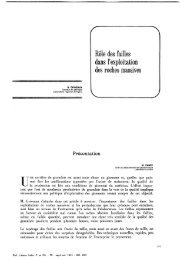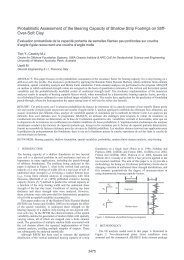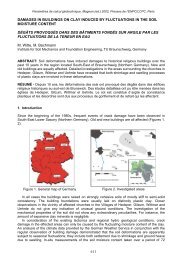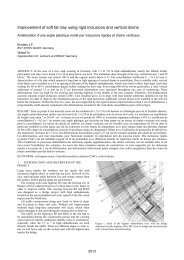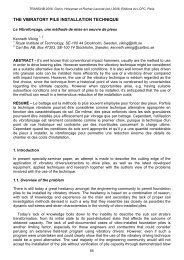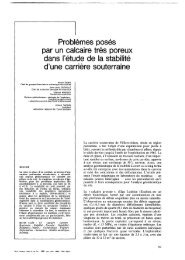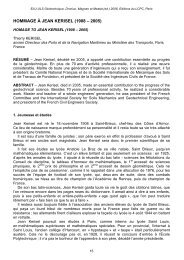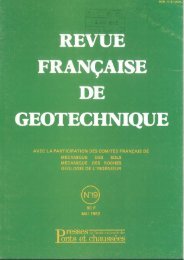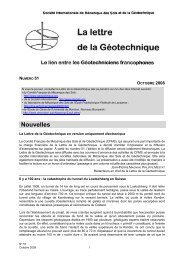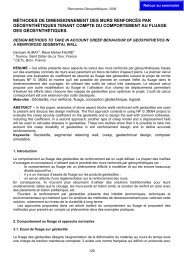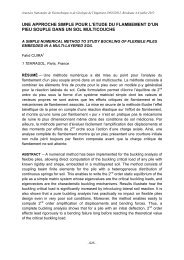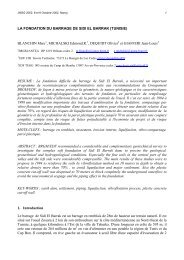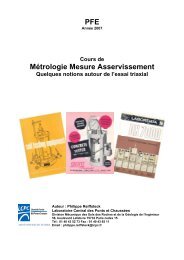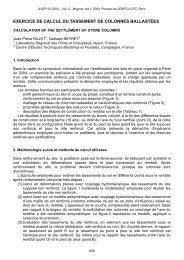La Craie
La Craie
La Craie
Create successful ePaper yourself
Turn your PDF publications into a flip-book with our unique Google optimized e-Paper software.
Foundations in chalk<br />
F. BAGUELIN.<br />
After referring to the difficulties encountered in taking chalk samples which can be used in the laboratory<br />
and the resulting dispersion of mechanical characteristics, the author shows the advantages<br />
of in situ measurements, in particular pressiometric measurements, for assessing the overall reaction<br />
of chalk in the mass.<br />
Observations and experiments have shown that calculations based on these various tests were pessimistic,<br />
especially dynamic driving formulae employed in the case of driven foundation piles. Chalk<br />
tends to liquefy under the effect of impacts, and recovers its mechanical strength after driving either<br />
by dissipation under excess pore pressure or by a thixotropic restructuring of the chalk of which<br />
little is so far known.<br />
<strong>La</strong> craie. Bull. Liaison <strong>La</strong>bo. P. et Ch., special V, oct. 1973, p. 113.<br />
Underground cavities in the chalk soil of Northern France<br />
J. LEPLAT.<br />
The chalk of Northern France was formerly worked intensively to meet the needs of agriculture<br />
and especially the building industry. In this latter sector, the production of buiding stone, which<br />
at that time had to be extracted from below ground, led to the opening of a large number of quarries<br />
which are being rediscovered by present-day major projects.<br />
The frequent absence of reliable records, the gradual loss of information formerly handed down<br />
from father to son, makes the prospection of these underground cavities very difficult. In any event,<br />
the essential starting point is a thorough geological knowledge of the region, which makes it passible<br />
to select and valorize data gathered during the field survey (for example by taking account of the<br />
fact that building chalk is almost always located at the same stratigraphic level). The next stage should<br />
be a gravimetric campaign, the only method of geophysical prospection applicable to all cases in<br />
this region. Professor Gabillard's electromagnetic method is designed for the detection of cavities<br />
of the « bottle » type in the region of Lille. Though it is accurate and effective in this particular case,<br />
its possibilities over the whole area are relatively limited. When the gravimetric or electromagnetic<br />
prospection reveals negative anomalies attributable to underground cavities, then mechanical<br />
means of reconnaissance must be employed. In favourable cases (numerous access shafts, shallow<br />
cavities) recourse can be had to devices of the penetrometer type ; otherwise, drilling is necessary.<br />
As soon as a cavity has been detected, the final stage is to enter it in order to survey it.<br />
For the treatment of underground cavities in chalk, two types of solutions may be adopted : filling<br />
in or tidying up. Filling in is reliable but costly ; in this region it is done by introducing quarry<br />
aggregate pneumatically, or by injecting a grout of fly ash and cement. The latter solution seems<br />
to be more reliable and less costly. Tidying up must be apdapted to the particular conditions, and<br />
consequently takes various forms, the simplest being the construction of access shafts allowing<br />
the cavity to be supervised periodically.<br />
<strong>La</strong> craie, Bull. Liaison <strong>La</strong>bo. P. et Ch., special V, oct. 1973, p. 123.<br />
Chalk in electric power station construction sites<br />
G. COMES.<br />
The Division Geologie-Geotechnique of the Direction de l'Equipement de l'Electricité de France<br />
has in the course of the past five years to study chalk as a foundation material as a consequence of<br />
the evolution in the building and siting of electric power stations.<br />
The mechanical characteristics of chalk are such that this material behaves very differently from<br />
the rocks usually encountered in connection with these types of structures, such as granite, shale,<br />
limestone, etc.<br />
The sites studied are located at various points of the Paris Basin, taking that area in its widest sense.<br />
The geological and geotechnical work undertaken was performed on Senonian chalk in the Champenois<br />
and Cauchois localities.<br />
The geotechnical characteristics of the chalks in question were determined in the laboratory and in<br />
situ. The behaviour of the material in place is examined and analysed in this article.<br />
It is possible to build underground structures in chalk provided that a certain number of precautions<br />
of a technological nature are taken while the work is in progress.<br />
<strong>La</strong> craie, Bull. Liaison <strong>La</strong>bo. P. et Ch., spécial V, oct. 1973, p. 149.<br />
177



